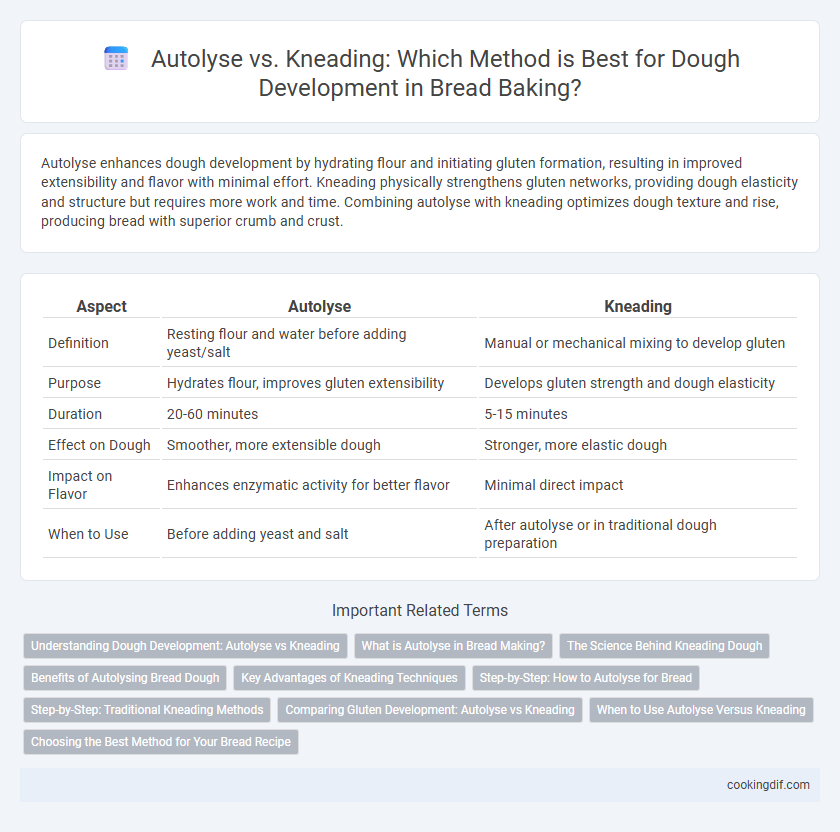Autolyse enhances dough development by hydrating flour and initiating gluten formation, resulting in improved extensibility and flavor with minimal effort. Kneading physically strengthens gluten networks, providing dough elasticity and structure but requires more work and time. Combining autolyse with kneading optimizes dough texture and rise, producing bread with superior crumb and crust.
Table of Comparison
| Aspect | Autolyse | Kneading |
|---|---|---|
| Definition | Resting flour and water before adding yeast/salt | Manual or mechanical mixing to develop gluten |
| Purpose | Hydrates flour, improves gluten extensibility | Develops gluten strength and dough elasticity |
| Duration | 20-60 minutes | 5-15 minutes |
| Effect on Dough | Smoother, more extensible dough | Stronger, more elastic dough |
| Impact on Flavor | Enhances enzymatic activity for better flavor | Minimal direct impact |
| When to Use | Before adding yeast and salt | After autolyse or in traditional dough preparation |
Understanding Dough Development: Autolyse vs Kneading
Autolyse enhances dough development by allowing flour hydration and enzyme activity to naturally improve gluten formation and dough extensibility, reducing oxidation and enhancing flavor. Kneading mechanically develops gluten strands, creating a stronger, more elastic dough structure necessary for trapping fermentation gases and supporting bread rise. Combining autolyse and kneading optimizes both biochemical and physical processes, resulting in superior dough texture and bread quality.
What is Autolyse in Bread Making?
Autolyse in bread making is a technique where flour and water are mixed and rested before adding yeast and salt, allowing enzymatic activity to hydrate flour and break down proteins. This process improves dough extensibility, enhances gluten development, and results in better texture and flavor without immediate kneading. Autolyse reduces kneading time and promotes more efficient fermentation for artisanal bread.
The Science Behind Kneading Dough
Kneading dough activates gluten proteins through mechanical stretching, aligning glutenin and gliadin molecules to form a strong, elastic network essential for trapping carbon dioxide during fermentation. This process enhances dough structure, improves gas retention, and contributes to bread's volume and crumb texture. The science behind kneading emphasizes its role in developing gluten strength and dough extensibility, critical factors for final bread quality.
Benefits of Autolysing Bread Dough
Autolysing bread dough enhances gluten development by allowing flour and water to hydrate fully before kneading, resulting in a more extensible and easier-to-shape dough. This process improves dough texture, reduces mixing time, and promotes enzymatic activity that enhances flavor and crumb structure. Bakers achieve superior loaf volume and crust quality by incorporating autolyse into their bread-making routine.
Key Advantages of Kneading Techniques
Kneading enhances gluten development by aligning protein strands, resulting in improved dough elasticity and structure essential for artisan bread. This technique allows for better incorporation of air, promoting yeast activity and fermentation, which leads to a lighter crumb texture. Compared to autolyse, kneading offers precise control over dough consistency and hydration, optimizing the final bread quality.
Step-by-Step: How to Autolyse for Bread
Autolyse enhances dough development by mixing flour and water, then resting the mixture for 20 to 60 minutes to naturally hydrate flour and activate enzymes, improving gluten formation and dough extensibility. Avoid adding salt or yeast during autolyse, as these ingredients inhibit enzymatic activity and yeast fermentation at this stage. After autolyse, incorporate salt and yeast before kneading to strengthen gluten structure and develop flavor in the final bread.
Step-by-Step: Traditional Kneading Methods
Traditional kneading methods involve a step-by-step process where flour and water are mixed before adding yeast and salt, ensuring proper gluten development and dough elasticity. This technique requires consistent folding and pressing motions over 10 to 15 minutes to create a smooth, elastic dough structure essential for a well-risen bread. Unlike autolyse, traditional kneading blends all ingredients immediately, promoting thorough integration but demanding more manual effort for optimal dough strength.
Comparing Gluten Development: Autolyse vs Kneading
Autolyse enhances gluten development by hydrating flour and initiating enzymatic activity before mixing, resulting in a more extensible and well-structured dough. Kneading physically aligns and stretches gluten strands, creating a strong network essential for dough elasticity and gas retention. While autolyse optimizes dough texture and fermentation, kneading remains crucial for building gluten strength necessary for bread volume and crumb structure.
When to Use Autolyse Versus Kneading
Autolyse is ideal for flour and water mixtures before adding salt and yeast, improving gluten development and dough extensibility with minimal effort and fermentation time. Kneading is essential after autolyse or when working with enriched doughs containing fats, sugars, or additional ingredients, to build a strong gluten network. Use autolyse for lean doughs targeting better texture and flavor, while kneading suits enriched or high-hydration doughs requiring more mechanical gluten development.
Choosing the Best Method for Your Bread Recipe
Autolyse enhances dough development by hydrating flour and initiating enzyme activity, resulting in improved gluten formation and better flavor, especially for artisan breads. Kneading, on the other hand, mechanically develops gluten networks, offering more control over dough texture and elasticity, which suits enriched or whole grain recipes. Selecting between autolyse and kneading depends on your bread type and desired crumb structure, as autolyse benefits long fermentation and extensibility, while kneading ensures strength and resilience in the dough.
Autolyse vs Kneading for dough development Infographic

 cookingdif.com
cookingdif.com